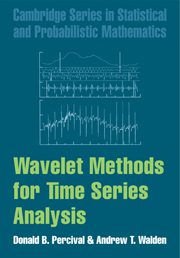Book contents
- Frontmatter
- Contents
- Preface
- Conventions and Notation
- 1 Introduction to Wavelets
- 2 Review of Fourier Theory and Filters
- 3 Orthonormal Transforms of Time Series
- 4 The Discrete Wavelet Transform
- 5 The Maximal Overlap Discrete WaveletTransform
- 6 The Discrete Wavelet Packet Transform
- 7 Random Variables and StochasticProcesses
- 8 The Wavelet Variance
- 9 Analysis and Synthesis of Long MemoryProcesses
- 10 Wavelet-Based Signal Estimation
- 11 Wavelet Analysis of Finite EnergySignals
- Appendix. Answers to Embedded Exercises
- References
- Author Index
- Subject Index
11 - Wavelet Analysis of Finite Energy Signals
Published online by Cambridge University Press: 05 December 2013
- Frontmatter
- Contents
- Preface
- Conventions and Notation
- 1 Introduction to Wavelets
- 2 Review of Fourier Theory and Filters
- 3 Orthonormal Transforms of Time Series
- 4 The Discrete Wavelet Transform
- 5 The Maximal Overlap Discrete WaveletTransform
- 6 The Discrete Wavelet Packet Transform
- 7 Random Variables and StochasticProcesses
- 8 The Wavelet Variance
- 9 Analysis and Synthesis of Long MemoryProcesses
- 10 Wavelet-Based Signal Estimation
- 11 Wavelet Analysis of Finite EnergySignals
- Appendix. Answers to Embedded Exercises
- References
- Author Index
- Subject Index
Summary
Introduction
The continuous time wavelet transform is becoming a well-established tool for multiple scale representation of a continuous time ‘signal,’ which by definition is a finite energy function denned over the entire real axis. This transform essentially correlates a signal with ‘stretched’ versions of a wavelet function (in essence a continuous time band-pass filter) and yields a multiresolution representation of the signal. In this chapter we summarize the important ideas and results for the multiresolution view of the continuous time wavelet transform. Our primary intent is to demonstrate the close relationship between continuous time wavelet analysis and the discrete time wavelet analysis presented in Chapter 4. To make this connection, we adopt a formalism that allows us to bridge the gap between the inner product convention used in mathematical discussions on wavelets and the filtering convention favored by engineers. For simplicity we deal only with signals, scaling functions and wavelet functions that are all taken to be real-valued. Only the case of dyadic wavelet analysis (where the scaling factor in the dilation of the basis function takes the value of two) is considered here.
- Type
- Chapter
- Information
- Wavelet Methods for Time Series Analysis , pp. 457 - 500Publisher: Cambridge University PressPrint publication year: 2000



